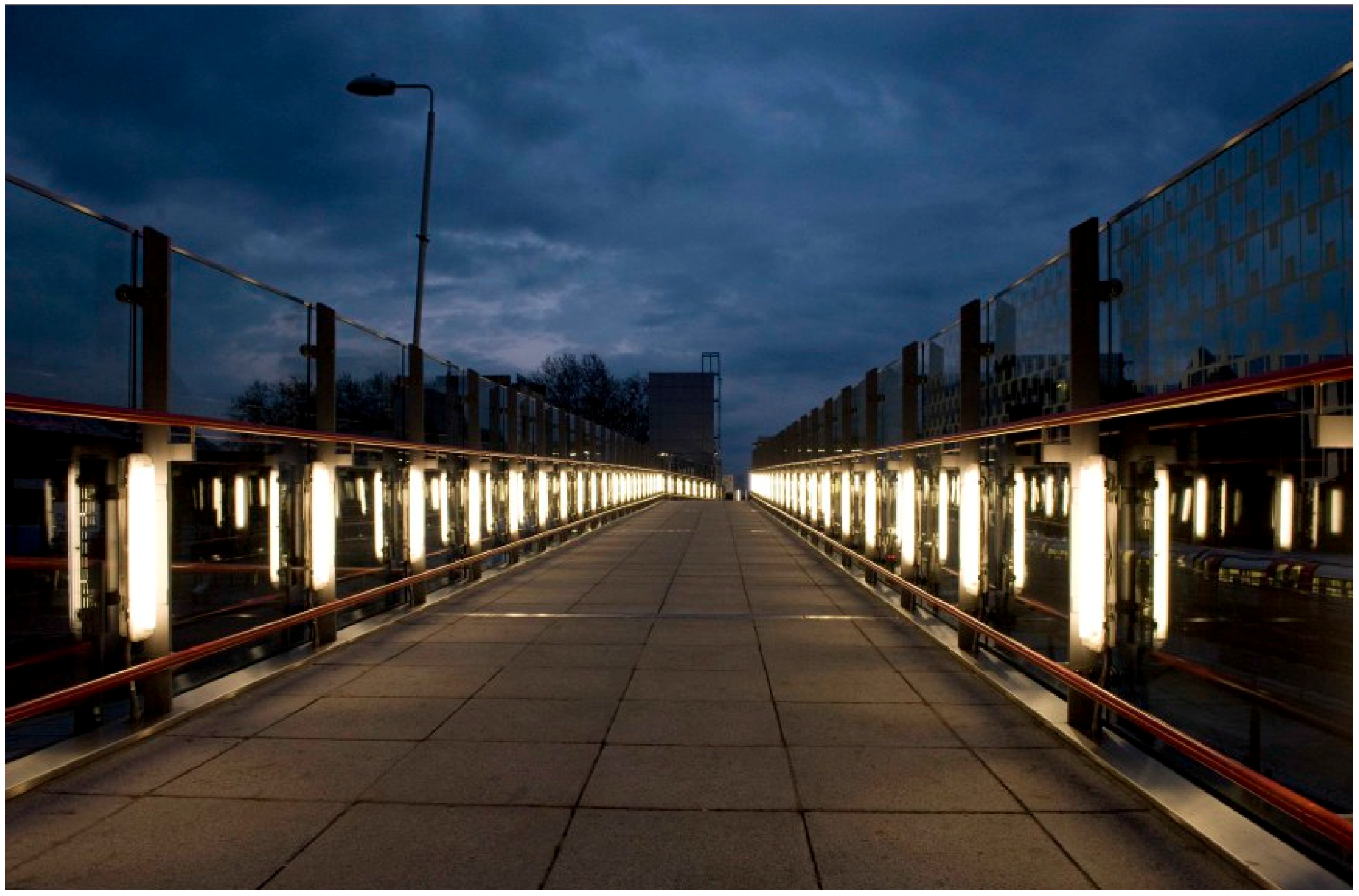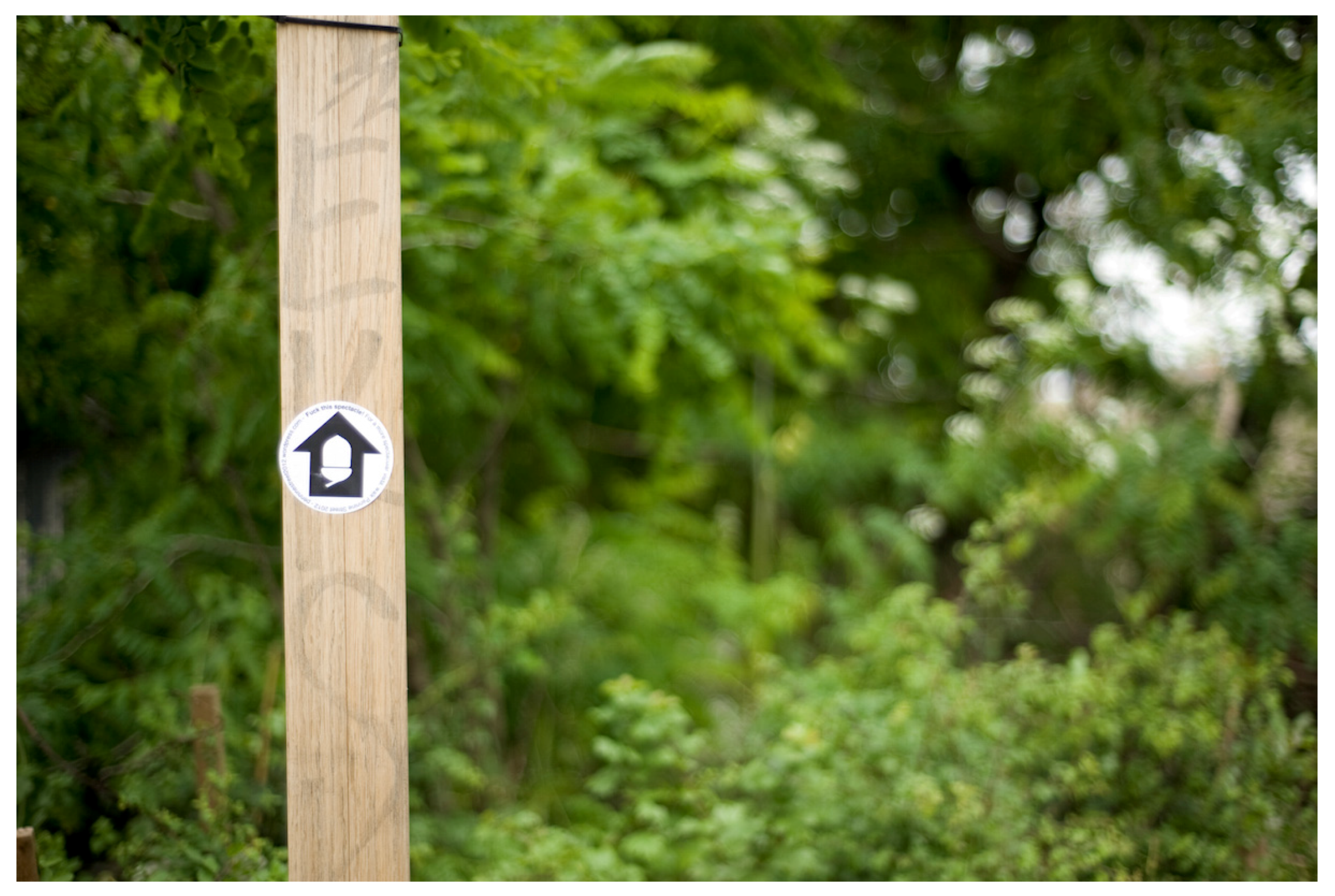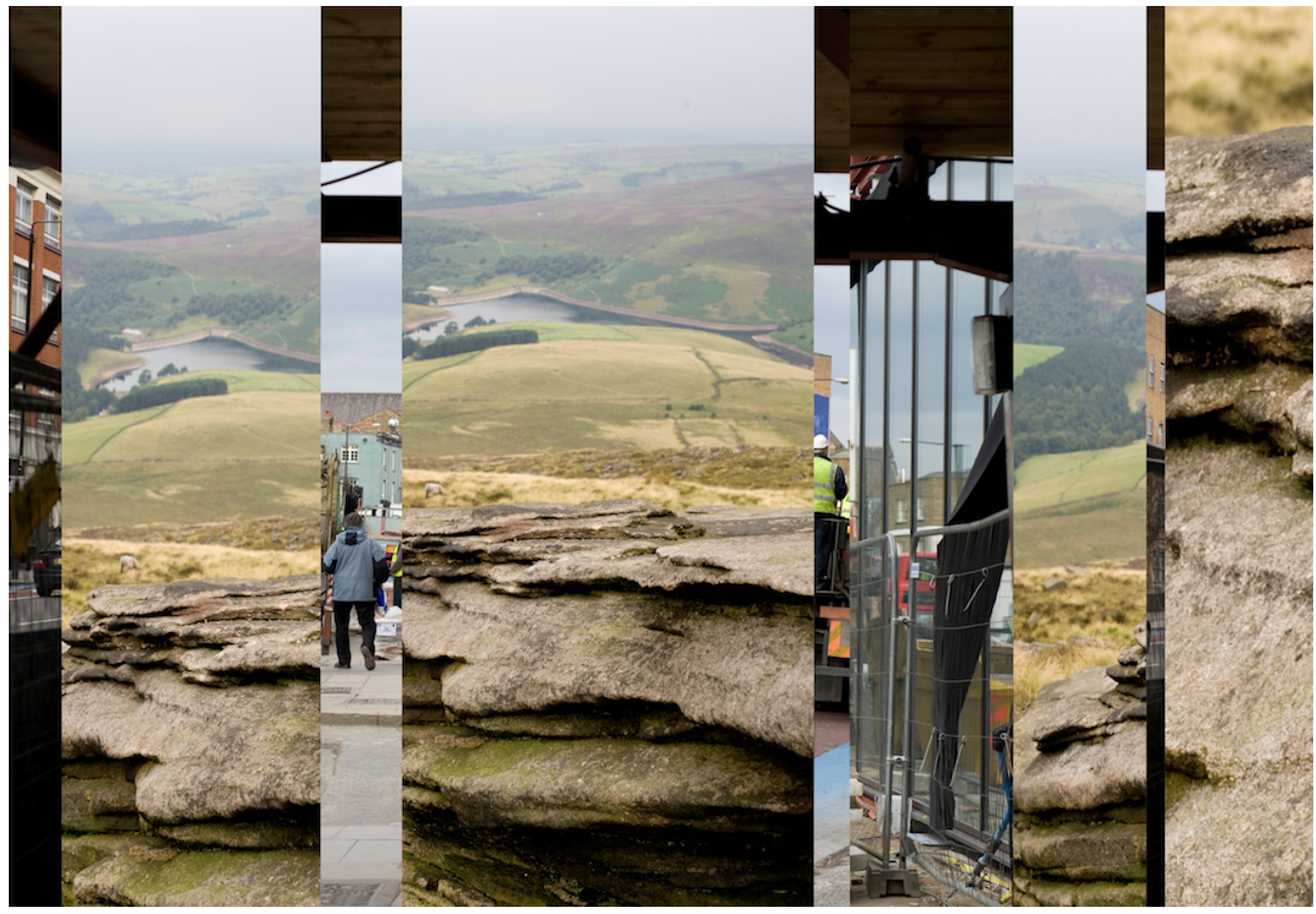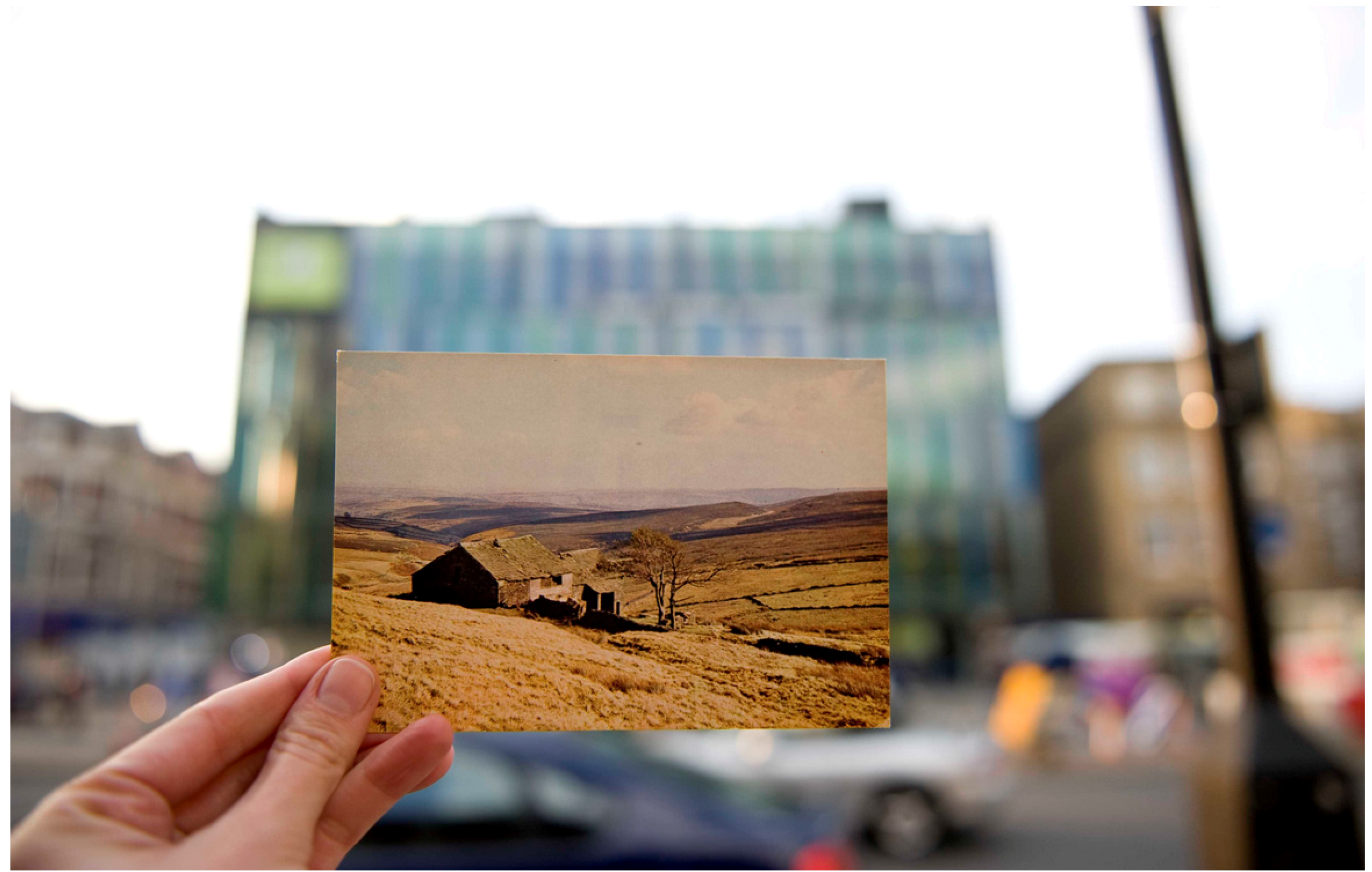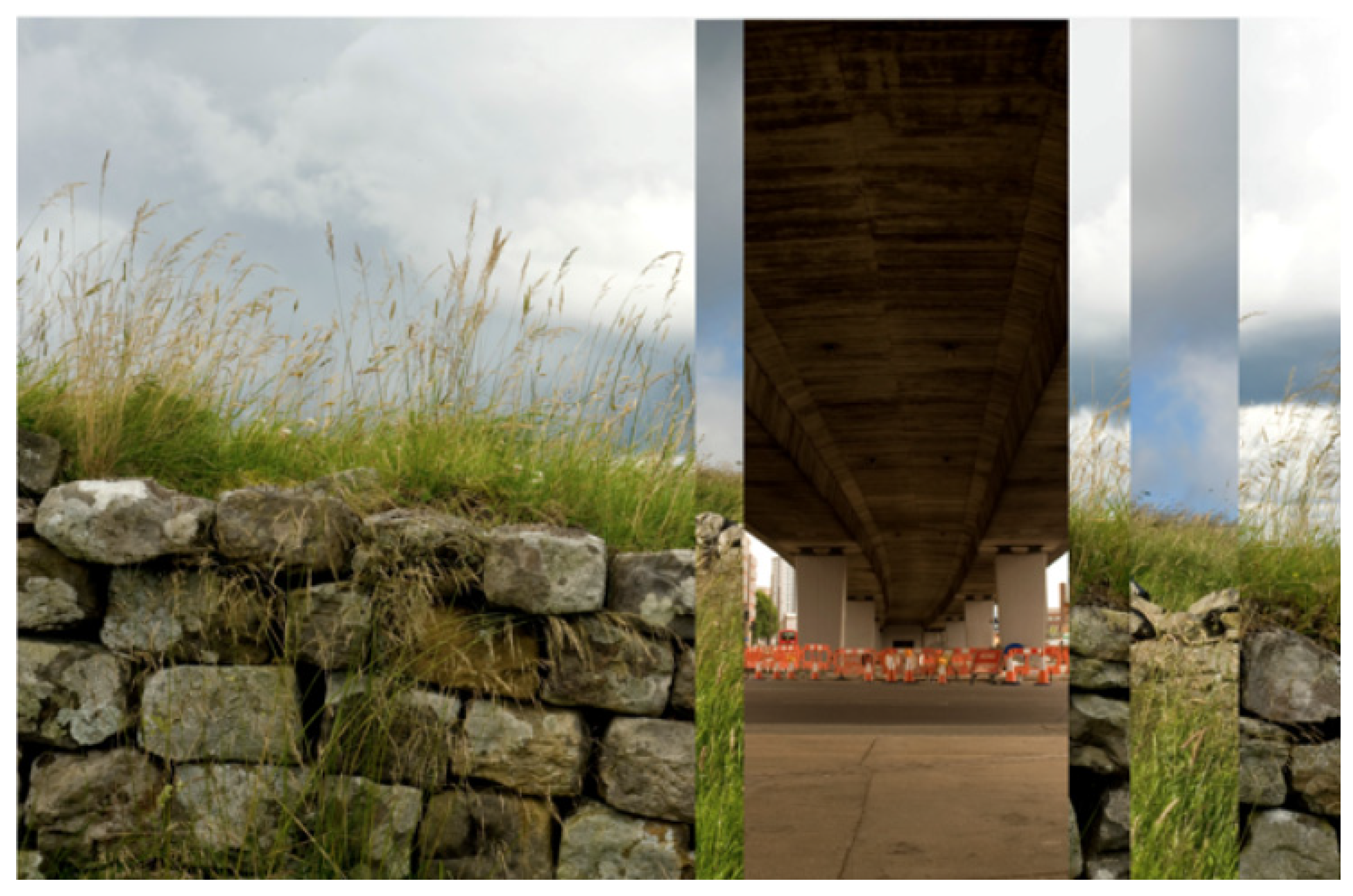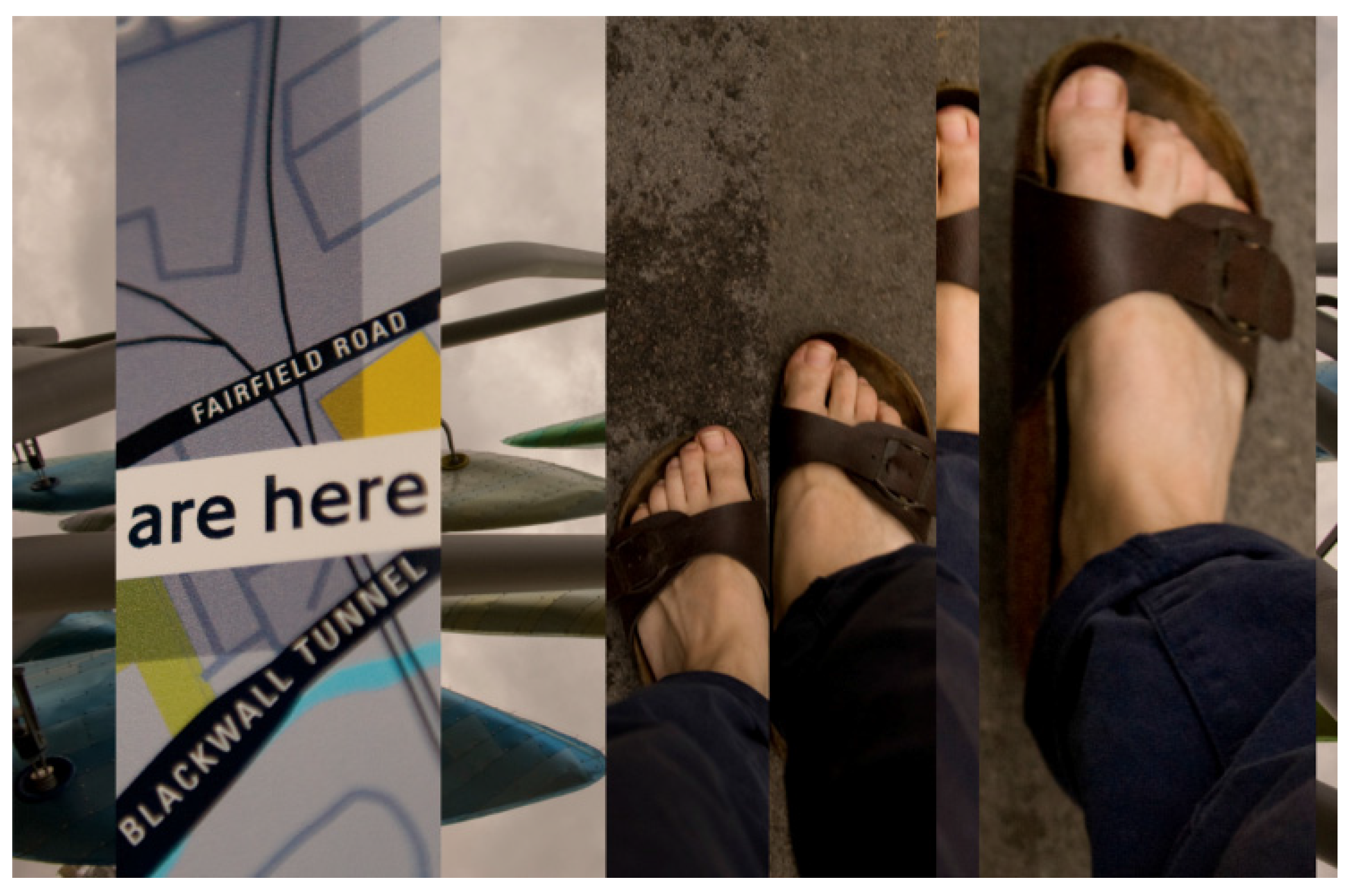1. Introduction
Pennine Street is a cartographic art experiment, twinning High Street 2012 in London with the Pennine Way, a long-distance footpath running between the Peak District and the Scottish Borders. In this article, I give an account of this as-yet open-ended critical art project that considers it as a form of “deep mapping”:
a deep mapping occupied with, and attempting to give an account of, both a particular geographically located “place” and, simultaneously, a second space-between that both mediates and contests the exclusionary position of the authorizing official networks of culture and knowledge.
Pennine Street may be understood as constituting such a “space-between”, that is able to mediate and to contest some of the dominant, “official” narratives that are currently functioning in the places of “east London” and the “Pennine Way”. Where the concept and practice of deep mapping is still emerging and finding definition as a way of exploring place, I offer Pennine Street as a project that may contribute to our understanding of deep mapping, and that may deepen its attention to imaginative and fictional aspects of place.
In this article, I describe how the project of Pennine Street began and how it developed, attending to the personal experience of creative production as well as to the theoretical and political concerns that prompted and continue to animate the work. As I discuss further below, the invention and exploration of Pennine Street was initially prompted by the advent of the Olympics in east London. However, it is also more broadly concerned to explore, and problematize, the categorization of places through their (ontological and political) incorporation into new named entities, and the experience of perceiving and encountering such abstractions. Beginning from a juxtaposition of the two routes as contrasts to one another—rural/urban, established/new, traditional/postmodern—the project attempts to complicate and disrupt such binary formations, to explore how these formations inform and co-constitute one another, and how a theoretically-inspired approach to creative action might be able to play out as a form of political response to the spectacular politics of mega-events such as the Olympics, and the harms they cause. These are the motivations and the interests of the project, though of course I do not suggest that any of these issues are “answered” or resolved here.
The much larger political question of the effectiveness of protest is, for me, one of the most important unresolved questions of the Pennine Street project. With the conviction that conventional forms of direct action, demonstration and non-violent resistance would have no effect on the implementation and “success” of the Olympics, I made the also-ineffectual choice to develop a creative and theoretically-informed artistic project to attempt to address some of the underlying conceptual dynamics that make such phenomena possible; including considering how places can be defined and re-defined in this particular cultural moment; how the power to undertake processes of definition works through institutions and conventions such as naming; and how we might be able to re-consider what is accepted as “real” and “natural” through taking up an interest in fiction and imagination. These considerations have informed the development of Pennine Street as a resistant, imaginative response to the Olympic project, though they are, of course, not resolved in the project.
3. Walking “against” the Olympics
Pennine Street was initially prompted by the London 2012 Olympic spectacle; more specifically, by the militarization of the Games through the proposed deployment of surface-to-air missiles at sites in London. Its starting premise was to imaginatively, and performatively, “twin” two routes that I found to be personally significant and politically resonant at that moment in 2012: the so-called “High Street 2012” and the long-distance path known as the Pennine Way. High Street 2012 was an almost invisible phenomenon of the London 2012 Olympics. Re-branding the A11 between Aldgate and Stratford, in east London, High Street 2012 provided a rubric under which some refurbishment work was undertaken to the “public realm” along the route between the City of London and the Olympic site. By apparent contrast, the Pennine Way was established in 1965 as the first National Trail in Britain, allowing public access to a continuous stretch of footpaths, offering members of the public “a once in a lifetime experience” [
5]. Running between Edale in Derbyshire and Kirk Yetholm in the Scottish Borders, the Pennine Way is 268 miles long and includes the most remote parts of the country to be designated as national trails.
The idea to “twin” these two very different routes emerged as my confused and wounded response, as researcher, artist and local resident, to the militarization of the London Olympics. A planned holiday to walk the Pennine Way became an opportunity to remove myself from immediate proximity to the Olympic spectacle while it took place, and to form an artistic response to both the political project of the Olympics and my own experience of it as a violating imposition.
Taking up the idea of twinned routes, the project initially took the form of three organized walks along the route of High Street 2012, from Aldgate to Stratford. Open to the public, the walks, named “Pennine Street Trespasses”, were taken by small groups, who were invited to bring and read texts of any kind that they felt had a connection to the concerns of the project. (This participatory element of the project proved to be less successful than anticipated, and came to function as a prompt for my further reading and research rather than as a methodology that played a central role in the Pennine Street project.) The walks were explicitly framed as an act of both homage and parody of the Kinder Trespass of 1932, in which ramblers organized a Mass Trespass at Kinder Scout in the Derbyshire Peak District. The first Pennine Street Trespass took place on 24th April 2012, the 80th anniversary of the Kinder Trespass. This event plays a central role in contemporary narratives of struggle and political contestation of restrictions to access to the land, and through Pennine Street I attempt to open out a space to examine and challenge my own attitude to the Trespass, as well as its enrolment in somewhat triumphalist contemporary discourses of struggle.
I particularly wanted to complicate my own received impression of a simplified narrative in relation to the Kinder Trespass; based on partial awarenesses gathered as a walker, through reading websites and guidebooks, and consuming media such as newspapers and radio programmes, I wanted to make my own (partial, inadequate) process of impression-formation an object of inquiry and criticism as much as the “external” objects of inquiry such as the routes and their histories. Therefore rather than presenting an account of current attitudes towards, and uses of, the Kinder Trespass that aspired to intellectual objectivity, I was concerned to question my own perspective, particularly as someone without experience of any of the struggles for access to the private land on which the Pennine Way was established privileged position of being able to “escape” the Olympics.
I saw in the Pennine Way, and its establishment as the first “national trail” in Britain, a narrative of a constructed route as metonymic of the nation (the National Trails website and the official guidebook, also published by Natural England, both refer to the Pennine Way as following “the backbone of England” ([
5]; [
6], p. 12). In twinning the two routes, then, I was partly interested to position High Street 2012 in relationship to the Pennine Way as a cynical or inadequate national metonym for the early twenty-first century; where the Pennine Way has inspired hyperbole it also offers rich and rewarding experience, forming a problematic, questioning binary with High Street 2012 as offering no comparable opportunities.
The three walks followed the route of High Street 2012 between Aldgate and Stratford; the first and third walks proceeded west to east, and the second walk, east to west. Readings were made while walking on each occasion (to which I return, below). I took as the end of High Street 2012 the location of the final improvement project along the route; Stratford High Street DLR (Docklands Light Railway) Station (see
Figure 1). This site is a short walk away from the main Stratford Station, which includes Overground and Underground trains and which saw extensive improvement works ahead of the Olympics. The distance between the end of High Street 2012 and the main station providing access to the Olympic site became amplified in the imaginary of Pennine Street, as a sign of the feeling of bureaucratic ineptitude, of plans being slightly off and unfinished, delayed. I connected this impression with my sense of the futility of physical, or legal, trespass; my feeling of powerlessness in the face of the Olympic spectacle. In this I also saw a certain problematic “sublimity” that I found myself attributing to the Olympics as a whole. In response to these considerations, I read the well-known “tilting at windmills” passage from
Don Quixote by Miguel de Cervantes at the Stratford High Street DLR Station, and photographed the new lighting scheme:
Figure 1.
Stratford High Street DLR Station, 2012.
Figure 1.
Stratford High Street DLR Station, 2012.
A series of subsequent walks enabled me to photograph more of the route, and to extend the idea of trespass in the project through stickering. Stickers were placed along the route and its environs, offering waymarkers for the (non-existent) walker to follow (see
Figure 2 and
Figure 3). On a personal level, I was surprised at how self-conscious I felt at making this very minor transgression, of placing stickers in public places, on signage and street furniture. I was not carrying out an act of trespass in the conventional and politicized sense of accessing land that is private or otherwise forbidden; rather, I considered that this attempt was to “trespass” in plain sight, so to speak, by unofficially and ineffectually declaring public spaces to be part of the new, non-official and fictional space of Pennine Street.
Figure 2.
The Pennine Street waymarker sticker.
Figure 2.
The Pennine Street waymarker sticker.
Figure 3.
One of the waymarker stickers in position.
Figure 3.
One of the waymarker stickers in position.
4. Trespass: Homage and Parody
In seeking to make a response of some kind to the imposition of the militarized Olympic spectacle, I took up the idea of “trespass” from two areas: the discourse of contemporary activism at large, in which trespass is often used as a form of resistance, and the particular event of historical trespass associated with the establishment of the Pennine Way, the “mass trespass” carried out at Kinder Scout in 1932. I was interested in this event and its subsequent uses, in terms of attempting to critique what I saw as its problematic contemporary deployment as a “success story” of popular political action, while at the same time admiring its effectiveness. The “Kinder Trespass” functions as both a justification and an inspiration for the “access movement” that continues today. This framing of the Kinder Trespass is exemplified by the Ramblers’ online presentation of the 80th anniversary in 2012:
On 24 April 1932, groups of ramblers left Manchester and Sheffield for an organized trespass onto Kinder Scout, a moorland plateau in what is now the Peak District. There they clashed with gamekeepers sent by local landowners to keep people off their land. The clashes were violent and several of the ramblers were arrested and imprisoned, but over the following days and weeks much larger trespasses were held and public opinion started to sway in the trespassers’ favour.
Today, it is possible to trace the Kinder Scout trespass as the start of an access movement that saw the establishment of National Parks, long distance footpaths including National Trails and finally, the Countryside and Rights of Way Act 2000 which granted unrestricted access to 10,000 square kilometres of countryside in England and Wales. The Ramblers, as a national charity concerned with the promotion of both access to the land, and walking per se, also cites the Kinder Trespass as a central moment in its account of its own history.
In developing Pennine Street, I have wanted both to rail against the neatness and over-simplification of the deployment of the Kinder Trespass as an anchoring event in the narrative of “the access movement”, but also to venerate it myself; to consider my own sense of gratitude for the fact of access that the Trespassers’ activism and effort has generated and that is extremely important to me; and also to confront the tensions involved in performing a bourgeois subject position in relation to a movement that has been positioned as a working class victory against the figure of the bourgeois landowner, or more particularly, the departicularized figure of the “gamekeeper”. Standing in for any actual landowner in accounts of the Trespass, the gamekeeper provides a coherent antagonist to the trespasser. Here again a paring-down, a critical simplification, of the presence and role of this figure takes place; for example, injuries to gamekeepers are cited in more in-depth accounts and left unmentioned in briefer and more widely circulated accounts, while the fact of imprisonment for the trespassers survives the simplification process [
8].
I read in this narrativizing process a deep ambivalence toward the question of violence and violation in the Trespass as a political action. Physical violence (the gamekeeper’s broken leg) is effaced in favour of symbolic violence—enacted at the level of the law rather than the level of the person. In Pennine Street, through positioning the initial walks as “trespasses” held in both homage and parody to the Kinder Trespassers, I attempted to perform some of my own sense of conflictedness about the importance of symbolic action as well as its non-effectiveness at the immediate political level. That is, I was very aware that any action of trespass or physical resistance to the Olympics that I could make would have no effect on their going ahead, but still felt that attempting to intervene at the level of the symbolic was important and possible. It was this sense of conflictedness itself that I attempted to evoke and explore through the idea of the walks as both homage and parody.
The visual register of Pennine Street also attempts to explore the notion of “trespass” through collage (see
Figure 4)—“trespassing” the integral image in favour of images that disrupt and violate one another—appropriating imagery, and stickering (see
Figure 2 and
Figure 3). The walks generated a lot of photographic imagery, which I experimented with using collage as a visual analogue of the twinning, combining and interspersing of places proposed by the project as a whole. These visual experiments enabled the incorporation of photographs from the Pennine Way, as well as the appropriation of parts of maps, particularly Google Maps (see
Figure 5).
Figure 4.
Early collage “sketch” incorporating photographs of the Kinder Plateau, Derbyshire and Mile End, London.
Figure 4.
Early collage “sketch” incorporating photographs of the Kinder Plateau, Derbyshire and Mile End, London.
Figure 5.
Early collage “sketch” incorporating satellite map image of Balderhead Reservoir, County Durham, and photograph of Mile End, London.
Figure 5.
Early collage “sketch” incorporating satellite map image of Balderhead Reservoir, County Durham, and photograph of Mile End, London.
5. Declaring Twinned Places: Haworth Idea Store and Hadrian’s Interchange
The experiments in collage gave rise to a more particular twinning of specific locations along the two routes, attending, though not rigidly, to relative position in relation to the route as a whole (see
Figure 6). For example, the beginning of the route became “Aldgatedale”, incorporating toponymic reference to both Aldgate in London and Edale in Derbyshire; the end point became “Kirk Stratford High St DLR Station”, incorporating, in the same way, reference to Stratford High St DLR Station in London and Kirk Yetholm in the Scottish Borders. The need to map the routes more closely onto each other arose through making this more explicit correlation between the two routes.
Figure 6.
Early layout bringing the two routes into a parallel orientation, and abandoning relative scale.
Figure 6.
Early layout bringing the two routes into a parallel orientation, and abandoning relative scale.
Particular twinned locations were “declared”, including Haworth Idea Store (see
Figure 7), Stepney-in-Ribblesdale, Hadrian’s Interchange, Kielder-Stratford Forest and Hackney Heath. Haworth Idea Store was prompted by the emphasis placed on Haworth and Top Withins by the Pennine Way guidebook,
Pennine Way South: Edale to Bowes, as key locations of interest to the Pennine Way walker, thus:
Ahead and to the left is a broken spine of a wall leading to the ruins of Top Withins [...] Readers of Wuthering Heights may be disappointed by the first sight of this famous ruin, which has been “conserved”, but the view from the lonely steading is still wonderful. After passing Top Withins the Way drops downhill along a well-worn literary trail.
Figure 7.
Haworth Idea Store.
Figure 7.
Haworth Idea Store.
A further inset page is devoted to “The Brontёs of Haworth” ([
6], p. 69), and further describes Top Withins:
Top Withins, the inspiration for Wuthering Heights, beckons the more committed. Its setting is splendid and it should stir the imagination, but one of the most attractive things about a ruin is that it is insubstantial. It is a pity to see the once-crumbling remains of Top Withins enshrined as a blockhouse.
The emphasis, as well as the guidebook’s apparently straightforward treatment of a material ruin as the setting of a fiction, prompted the inclusion of “Haworth” as a place within Pennine Street. In the transposed mapping of the two routes, the “real” Whitechapel Idea Store in London occupies a geographical position within High Street 2012 that is roughly equivalent to Haworth’s position within the Pennine Way; that is, about a quarter of the way along their respective whole routes. The two locations are twinned, and juxtaposed, as sites of official, or institutional, interest, the library and the heritage site positioned as sites for the improvement of their visitors, and both centrally concerned with “fiction”. The resulting twinned site, Haworth Idea Store, was also photographed (see
Figure 7).
A concern with criticism is in play throughout the project, and specifically here in the choice to draw a connection between Top Withins and Haworth, and the Whitechapel Idea Store, through the idea of fiction. An angry, sardonic tone, or attitude, may be read as functioning at all times in the project and its specific moments, performing an aggressive degree of criticism that is simultaneously proffered and disavowed. This may be read in the “Haworth Idea Store” in terms of a conflicted attack on the phenomenon of the Idea Store, with its avowed aims of “reaching the non-learning public” [
9] while finding itself deeply entangled in contemporary politics of “place-making” ([
10], p. 12) and the ongoing gentrification of Whitechapel. These developments are metonymized in the Whitechapel Idea Store, which comes to stand for the simultaneous improvement of services for the “non-learning public” and their social and economic marginalization. “Non-learning” in this context functions as a euphemism for working- and sub-working class, itself a deeply racialized category in Tower Hamlets. For me, as against the official view [
11], the Idea Store is an ambivalent place of accessible learning dignified by designer architecture, on the one hand, and a place of emptiness and false promise on the other, offering a shockingly limited range of materials packaged for people whom the state (in the form of London Borough of Tower Hamlets) regards as having little value and scant potential for positive change. The concern with criticism in the project is partly, then, an anxiety about offering it at all toward a scheme widely regarded as successful; and partly with a self-reflexive awareness of the privilege of my own social and economic position in relation to those who are “targeted” ([
11], p. 58) by such services as the Idea Store.
Hadrian’s Interchange is the result of twinning the Bow Interchange in east London, a huge, multi-level, multi-lane gyratory, or roundabout, with Hadrian’s Wall, once the fortified northernmost boundary of Roman Britain, now a world heritage site and major tourist destination. I discuss Hadrian’s Interchange in more detail below.
The most recent photographic stage of Pennine Street is a series of photographic collages focussing on the new imaginary of “Hadrian’s Interchange” (see
Figure 8 and
Figure 9).
Figure 8.
Collage depicting Hadrian’s Interchange, composed of photographs of Hadrian’s Wall and Bow Interchange.
Figure 8.
Collage depicting Hadrian’s Interchange, composed of photographs of Hadrian’s Wall and Bow Interchange.
Figure 9.
Collage combining photographs of walking at Bow Interchange, sculptural “trees” at Stratford, and navigational map signage.
Figure 9.
Collage combining photographs of walking at Bow Interchange, sculptural “trees” at Stratford, and navigational map signage.
6. “Deep Mapping” of Pennine Street through Textual Collage
The final major element of Pennine Street is a piece of fictional writing, parodying the form of the guidebook, and comprised almost entirely of quotations (see
Figure 10). Initially, in wanting to form some sort of account of each Trespass walk, I drew on the texts that had been read out on the walk itself. Readings included the opening of
As I Walked Out One Midsummer Morning by Laurie Lee,
The Country and the City by Raymond Williams,
Gulliver’s Travels by Jonathan Swift,
The Return of the Native by Thomas Hardy, and “Toba Tek Singh” from
Kingdom’s End by Saadat Hasan Manto. Readings were interspersed with extracts from the two-volume guidebook,
Pennine Way South: Edale to Bowes and
Pennine Way North: Bowes to Kirk Yetholm, both by Tony Hopkins.
Figure 10.
Image of part of the Hadrian’s Interchange section of the collaged text. The footnotes are intended to be highly visible and to function as part of the reading experience, both informing and interrupting the reading.
Figure 10.
Image of part of the Hadrian’s Interchange section of the collaged text. The footnotes are intended to be highly visible and to function as part of the reading experience, both informing and interrupting the reading.
The guidebook became the central text for the project, due in part to my experience, when walking the Pennine Way using the guidebook, of Hopkins’ narrative voice becoming something of a fictional presence throughout the walk. Providing a would-be objective and comprehensive description of what the walker will see, and need to negotiate (for example roads or areas of wet ground or poor signage), the narrative voice of the guidebook also habitually “deviates” into idiosyncratic reflections on points such as the conservation of Top Withins, noted above, or comments on the walker’s “experience”: “When you walk into Hawes early, after a comparatively easy walk, you will wonder what all the fuss was about.” ([
6], p. 104) The guidebook as both an object and a narrative voice becomes a central feature of the experience of walking. It is read aloud, and re-read, particularly when its description proves difficult to connect with the landscape itself; it is protected from rain, and held in the hand while walking. The author’s idiosyncratic moments became moments to look forward to amid the succession of directions: “After crossing the lower meadows you begin to climb again” ([
6], p. 120); “the route follows the towpath beneath a little bridge” ([
6], p. 82); “just beyond this wood you bear right” ([
6], p. 86).
As this text had taken up such a central role in my experience and memory of walking the Pennine Way, I used it to structure both the readings on the Trespasses and the written accounts I produced afterwards. Extracts from the guidebook describing, for example, one’s view at a particular location, were interrupted with place-names taken from the map of east London. Extracts from the readings were also incorporated, drawing on the idea of collage used as a visual technique to “collage” the texts into new forms to create a fictional, imaginative “account” of walking Pennine Street—as though it were a “real” National Trail for which one could obtain a guidebook. The guidebook is structured by breaking down the whole route into manageable days of walking, for example, “4—Hebden Bridge to Ponden” and “5—Ponden to Thornton-in-Craven” [
6]. I took up this format, sub-dividing Pennine Street into a recommended five-day walk between particular twinned, or combined, places:
Day One: Aldgatedale to the Haworth Idea Store
Day Two: Haworth Idea Store to St Clement’s Lahore Hospital
Day Three: St Clement’s Lahore Hospital to Hadrian’s Interchange
Day Four: Hadrian’s Interchange to Kielder-Stratford Forest
Day Five: Kielder-Stratford Forest to Kirk Stratford High St DLR Station
The length of High Street 2012 is around 4.5 miles, and the length of the Pennine Way 268 miles, and this mode of textual division holds together the scales of both routes without collapsing one into the other. The proposition that it could take five days to walk the length of High Street 2012 is, of course, absurd, potentially comic, as is the proposition that it would be possible to walk the Pennine Way in five days. A new sense of time and distance is suggested in the insistence on the scales and sizes of both routes.
The “twinned place” of Hadrian’s Interchange offers an opportunity to consider in more detail how this place is evoked in Pennine Street through textual collage. The Interchange comes in the section “Day Three: St Clement’s Lahore Hospital to Hadrian’s Interchange” (see
Figure 10).
Here, the first line comes from the guidebook by Tony Hopkins, Pennine Way South: Edale to Bowes, then from the “High Street 2012” website, then the guidebook again, with altered place names added by me. The idea of Hadrian’s Interchange is of interest for me partly because of the sense, picked up in this passage, of a boundary or a point of transition, to the east of which is beyond what I think of as “my” east London. One crosses the River Lea, which is quite dwarfed by the structure of the roundabout and flyover. Thinking of this bleak urban space in conjunction with Hadrian’s Wall gives an opportunity to consider the constitutive binaries of the military boundary, which was the Wall’s original purpose, against the spatial boundary of the road and the river. Hadrian’s Wall is now exclusively and relentlessly a site of leisure, and cultural consumption, but still controlled and protected. The guidebook’s overbearing instruction on the need for a vivid imagination now comes to apply to both spaces; it retains its reference to Hadrian’s Wall, and, placed in this new narrative context, it refers also to the incompleteness of the project of High Street 2012, which was originally part of the package of benefits that were supposed to accrue to the local area and the people who live there, but which were significantly diminished in the actual course of events.
There is both humour and performativity in the idea that this urban place could be proposed as somewhere that one might deliberately visit for the purpose of leisure, which as far as I can tell, no-one does. It is used as a shortcut by locals, but its layout does not provide for pedestrian access to the central space of the Interchange. The twinned place poses the further question, then, of what kinds of walking and access are understood as “leisure” and which kinds understood as “necessity” or everyday life. The need for a “vivid imagination”, in this context, comes to refer also to the degree of imagination that may be required for those of us who are not compelled to live in this place to understand how it is done. The question of everyday life, and an imaginative engagement with how others live, was, I argue, absent from the project of High Street 2012.
The fictional Guidebook simultaneously offers an account and a guide to the imagined route, Pennine Street. The photographic collages act as illustrations to this imagined route, and are positioned at the relevant locations in the text, replicating the illustrative role of (non-collaged) photographic illustrations in the original guidebook. In this way, the capacity of photography to evoke the potential visual experience of the walker is disrupted through presenting altered images that “fail” to convey what may be seen when one is in place. The places that are combined in the images interrupt and supplement one another, resisting a coherent presentation of place. In the same spirit, the Guidebook’s composition from quotations also stages this kind of interruption and deliberate lack of coherence. This mode of collaged writing came about in response to my desire to have the original voices and utterances of the “Trespass” texts appear directly, rather than being summarized or re-phrased, and my concurrent concern with learning and navigating the rules and conventions of academic writing as a PhD researcher.
The collaged text came to function as a way to experiment with taking up words written by others and my awareness of the violation entailed in the process of quotation, of making a selection from a coherent whole text, and re-presenting this selection in a new textual setting. I considered this approach in light of the initial concern with trespass, as a form of textual rather than physical trespass. I was also concerned to explore, in this specific context, the broader idea of how creating something new (whether a new named route, or a piece of writing) can entail dismantling and reconfiguring prior work by others. This method also apes, and subverts, the processes of forming and declaring the existence of the two routes engaged with in Pennine Street: both the more positive process of forming the Pennine Way through existing pathways, and the more superficial process of declaring High Street 2012 as a re-imagining of an existing main road.
While the project is currently a work in progress, the present version of the “guidebook text” may be accessed at the project’s website [
12]. I intend to publish the work as an artist’s book, following the format of the guidebook with some of the photographic collages and hand drawn maps acting as guidebook illustrations. Further exploration of the ideas generated through the Pennine Street project could also take the form of replicating the twinning of two routes to create a third “space-between”. In the same way that the declaration of the Pennine Way as a National Trail led on to the establishment of further National Trails, so the same process of twinning could be productively applied in other locations.
What I suggest is “mapped” in Pennine Street, then, in the expanded sense of deep mapping, is a layering of means of depiction simultaneously with two posited geographical locations. At Hadrian’s Interchange in particular, as with Pennine Street as a whole, textual collage is combined with photographic collage to evoke a “new” imaginative place, beyond the empirical; a “space-between”. While Pennine Street continues to evolve, and therefore what is presented here is something of a report on a work in progress, I suggest that it indicates emerging possibilities for deep mapping to articulate and evoke imaginative aspects of place. In this way, approaches to place that we may consider under the rubric of deep mapping are able to push beyond the traditional cartographic concern with representation and engage with more political, and politicized, aspects of place and imagination.
